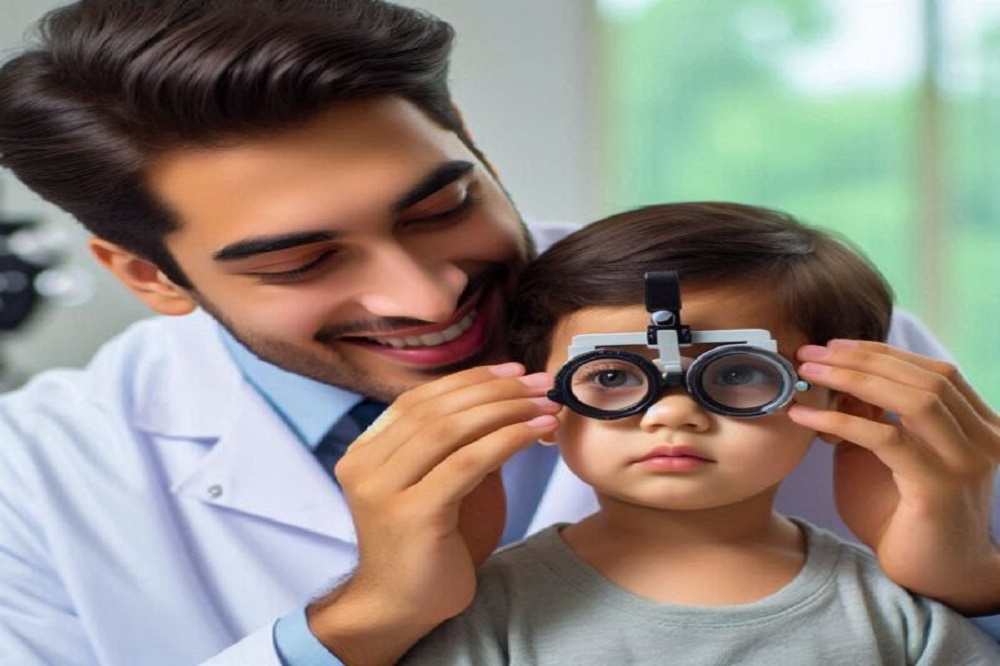
Is your child squinting, tilting their head to see, or covering one eye? These could be signs of a common yet often overlooked eye condition called amblyopia, or lazy eye.
Amblyopia, commonly known as lazy eye, is a vision development disorder where an eye fails to achieve normal visual acuity, even with prescription glasses or contact lenses. It is the most common cause of vision impairment in children and can persist into adulthood if left untreated. This blog will delve into the causes, diagnosis, and treatment of amblyopia in both children and adults. We’ll also explore different therapies, such as patch therapy, vision therapy, and atropine therapy, and discuss the importance of early intervention.
Read more: Retinal Detachment: A Vision Threat
What causes lazy eyes?
Amblyopia occurs when the brain and the affected eye are not working together correctly, leading the brain to favor the other eye. This condition often starts in early childhood, during the crucial years of vision development. Without proper treatment, amblyopia can result in permanent vision loss in the weaker eye.
Here are some common culprits:
- Refractive errors: Significant differences in the vision prescription (glasses or contact lenses) between the two eyes can cause amblyopia. For instance, one eye may be more nearsighted, farsighted, or astigmatic than the other, leading the brain to rely on the eye with clearer vision.
- Strabismus (Crossed Eyes): This is when the eyes don’t align properly, leading one eye to turn in, out, up, or down. The brain starts ignoring the misaligned eye to avoid double vision, causing amblyopia.
- Cataracts or other eye problems (Deprivation): Sometimes, conditions that block light from reaching the retina during early childhood can cause lazy eye such as cataracts or ptosis (droopy eyelid).
Read more: Dry Eyes: Find Relief for Scratchy, Irritated Eyes
Spotting the signs early is crucial.
While adults can also develop amblyopia, it’s most common in children. Keep an eye out for these symptoms:
- Squinting or Shutting One Eye: This can be a sign that the child is trying to improve their focus.
- Favoring One Eye: Consistently using one eye while covering or ignoring the other.
- Poor Eye Coordination: Eyes that don’t move together smoothly.
- Poor Depth Perception: Difficulty judging distances or depth.
- Head Tilting: Frequently tilting the head to see better.
Diagnosis of Amblyopia
Early diagnosis is key to preventing long-term vision problems. Regular eye exams for children can help catch amblyopia early. An eye doctor (ophthalmologist) will perform a comprehensive eye exam to assess vision clarity, eye alignment, and overall eye health.
Read more: Don’t Let Diabetes Steal Your Sight: A Guide to Diabetic Retinopathy
Vision Tests
- Visual Acuity Test: This test measures how clearly each eye can see.
- Refraction Test: This test determines the exact prescription needed for glasses.
- Alignment Test: The doctor will check how well the eyes work together by covering and uncovering each eye while the child focuses on a target, to rule out squint.
Read more: See Clearly: A Guide to Common Retinal Diseases
Delaying treatment can have serious consequences.

If left untreated, amblyopia can lead to permanent vision loss in the affected eye. This can impact a child’s ability to learn, drive, and participate in everyday activities.
Protect your child’s vision.
Regular eye exams are essential for detecting amblyopia early on. If you notice any signs of lazy eye, don’t hesitate to consult an eye specialist. Early intervention can make a world of difference.
At VIEW CARE, we’re committed to helping children achieve optimal vision. Our experienced team of eye specialists provides comprehensive diagnosis and treatment for amblyopia.
Don’t let lazy eye cloud your child’s future. Schedule an appointment today.
Read more: Cataracts: Regain Clear Vision with Modern Cataract Surgery
Adult Amblyopia: Can It Be Treated?
While treatment is most effective in children, adults with amblyopia can still benefit from certain therapies. Vision therapy and specialized exercises can help improve coordination and vision, although complete recovery is less likely.
Adult Treatment Options
- Vision Therapy: Tailored exercises can enhance eye coordination and function.
- Corrective Lenses: Wearing the appropriate prescription can optimize vision in both eyes.
- Consulting a Specialist: An eye specialist can provide personalized treatment plans and monitor progress.
Conclusion
Amblyopia, or lazy eye, is a common but treatable condition that affects many children and adults. Early diagnosis and intervention are crucial for preventing long-term vision problems. Treatments like patch therapy, vision therapy, and atropine therapy can help improve vision in the weaker eye. Wearing the correct glasses and undergoing regular eye exams are essential for managing amblyopia. If you suspect amblyopia in yourself or your child, consult an eye care professional for a comprehensive evaluation and personalized treatment plan.
Read more: Living with Glaucoma: A Clear Look at Management and Prevention
References
- American Association for Pediatric Ophthalmology and Strabismus (AAPOS). (n.d.). Amblyopia. Retrieved from AAPOS
- National Eye Institute (NEI). (n.d.). Facts About Amblyopia. Retrieved from NEI
- Mayo Clinic. (n.d.). Lazy eye (amblyopia). Retrieved from Mayo Clinic
By understanding amblyopia and its treatment options, you can take proactive steps to ensure better vision health for yourself or your loved ones. Early intervention is key to overcoming this condition and maintaining good eyesight throughout life.


